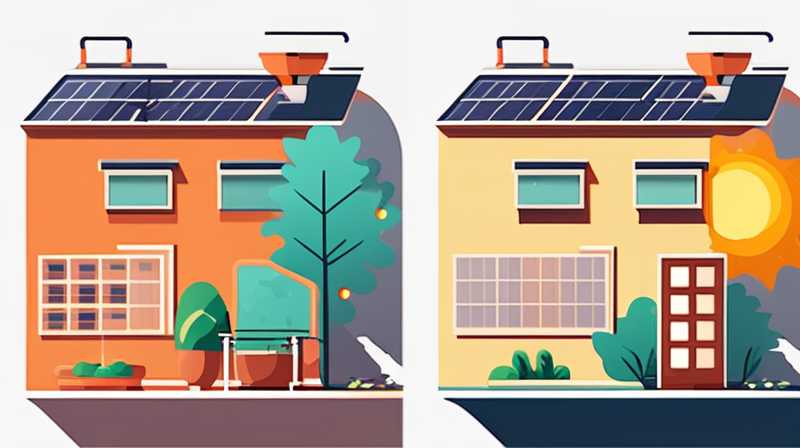
Hanging solar lamps indoors can be successfully accomplished by following these essential strategies: 1. Choose appropriate solar lamps designed for indoor use, 2. Select optimal locations that receive enough sunlight for charging, 3. Ensure reliable mounting methods that suit your space, 4. Maintain the solar lamps for longevity and performance.
Indoor spaces typically lack direct sunlight, making the selection of solar lamps crucial for effective function and aesthetic appeal. Indoor solar lamps typically utilize LED technology, allowing them to run efficiently even in low light after absorbing sunlight throughout the day. The location plays a significant role in the effectiveness of solar lamps, influencing their ability to gather sunlight for charging. By carefully considering these aspects, one can create a well-lit indoor environment that harnesses the beauty of solar-powered lighting without relying entirely on conventional electricity.
1. UNDERSTANDING SOLAR LAMPS
Solar lamps serve dual purposes: they provide illumination while promoting sustainability. These devices harness solar energy through photovoltaic panels which convert sunlight into electrical energy. With the growing concern over environmental issues, the popularity of solar lamps has increased remarkably. Unlike traditional lighting systems, solar lamps can operate independently, saving energy and reducing electricity bills.
When considering solar lamps for indoor spaces, it’s vital to recognize the differences between various types. Some lamps are designed predominantly for outdoor use and may not function efficiently in lower light settings found indoors. Therefore, consulting specifications and understanding the product is essential for desired performance. Recognizing the unique attributes of various solar lamps—including brightness, design, and battery capacity—will help in selecting the right model for your needs.
2. CHOOSING THE RIGHT LOCATION
Determining the optimal placement of solar lamps is essential for maximizing their efficiency. The primary factor to consider is sunlight availability. It is crucial to place solar lamps near windows or areas that receive adequate sunlight throughout the day. Generally, south-facing windows are ideal since they receive the most direct sunlight particularly during the midday hours.
In addition to sunlight exposure, it’s also important to consider the indoor space’s layout and design. The placement should enhance the room’s aesthetic while ensuring functional use. For example, a solar lamp positioned on a side table near a window can accentuate the decor while providing adequate light in the evenings. Furthermore, angling the solar lamps towards brighter areas can help maximize solar energy absorption.
3. INSTALLATION TECHNIQUES
Once the appropriate models and locations are determined, proper installation techniques become paramount. Mounting solar lamps securely is crucial to ensure they function correctly and can withstand any potential environmental factors, such as vibrations or accidental bumps. Methods of installation can vary, including using wall hooks, adjustable brackets, or adhesive strips, depending on the lamp’s design and your space’s requirements.
Wall-mounted lamps often require more precise installation, using tools such as drills and anchors to ensure stability. Adhering to the manufacturer’s instructions during installation will avoid any mishaps that might occur due to poor placement or installation practices. Additionally, incorporating adjustable components allows for repositioning the lamps to better capture sunlight during different seasons.
4. MAINTENANCE AND PERFORMANCE
Routine care and upkeep are vital to ensure the efficacy and lifespan of solar lamps. Keeping the solar panels free of dust and debris ensures better light absorption, thereby prolonging battery life. Regular checks on battery functionality help ascertain if replacements are necessary, particularly after prolonged usage.
Furthermore, it is advisable to store solar lamps in a dry location during extreme weather conditions. This extends the life of the lamps and minimizes wear due to humidity or adverse temperature fluctuations. Creating a consistent maintenance schedule for checking the lamps’ performance helps in understanding their longevity and efficiency in your indoor space.
FREQUENTLY ASKED QUESTIONS
CAN SOLAR LAMPS FUNCTION WITHOUT DIRECT SUNLIGHT?
While solar lamps are designed to operate primarily with exposure to sunlight, they can still function in limited light conditions. This stems from the fact that modern solar lamps utilize advanced technology, such as LED bulbs, allowing them to emit light even when fully charged under less than optimal sunlight conditions. However, it’s important to note that prolonged exposure to very low light will reduce performance levels. In such cases, selecting models that are efficient at converting low light into energy is beneficial.
HOW MUCH MAINTENANCE DO SOLAR LAMPS REQUIRE?
Maintenance for solar lamps can vary significantly based on their usage and environmental conditions. Generally, the key maintenance activities include cleaning the solar panels, checking battery health, and ensuring that the lamps are positioned correctly to receive maximum light exposure. Routine inspection of the physical components is also recommended to identify any signs of wear and tear. Performing these checks regularly can help prolong the lifespan of the solar lamps and maintain efficient operation.
CAN SOLAR LAMPS BE USED IN ALL INDOOR ENVIRONMENTS?
While solar lamps can be utilized in various indoor environments, specific considerations must be made regarding light exposure and decor compatibility. Certain spaces, such as dark basements or enclosed areas with minimal light access, may hinder the performance of solar lamps. On the other hand, brighter spaces such as sunrooms and areas with large windows are ideal for these lamps. Always choose products designed for indoor use to ensure they will perform adequately given the limited natural light exposure.
In summation, incorporating solar lamps indoors presents an innovative approach to sustainable lighting solutions. Understanding the intricacies of solar technology, effective placement, and proper installation fosters an environment conducive to both aesthetic appeal and energy efficiency. Choosing the right products tailored for indoor use ensures maximal benefit, while diligent maintenance practices guarantee extended functionality and performance. This amalgamation of factors underscores the practicality of solar lamps in enhancing indoor lighting, ultimately offering a delightful and eco-friendly ambiance. As individuals become more mindful of energy consumption and environmental impact, solar lighting systems will play a pivotal role in our domestic spaces, enhancing our lives while respecting the planet.
Original article by NenPower, If reposted, please credit the source: https://nenpower.com/blog/how-to-hang-solar-lamps-indoors/


